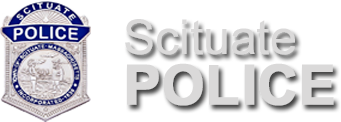Pedestrian Safety
Pedestrian safety is an issue that should be of vital concern to everyone in this community. People walk on or near the roadways of Scituate on a daily basis, and should be aware of some basic rules for doing this in a safe and responsible manner. Here are some tips for being a safe pedestrian:
If a Sidewalk is Available, Use It.
Sidewalks were designed as safe areas for pedestrians to use. Utilizing a sidewalk keeps you a safer distance from vehicular traffic, and in many cases, provide a small physical barrier in the form of a curb.
If There Is No Sidewalk, Walk On The Left Side Of The Road
By walking on the left side of the road, you are facing motor vehicles that are closest to you. This gives you a chance to see traffic more easily, and to react to it.
Wear Clothing That Is Easy To See
Bright colors and retro-reflective materials can increase your visibility to motorists. Retro-reflective materials can be seen up 500’ away at night, compared to 180’ for white clothing and as little as 80’ or less for darker clothing. The sooner a driver can see you, the easier it is for them to avoid you.
If You Walk At Night, Do More To Be Seen
Flashlights, strobe flashers and reflectors that are visible from both directions can help to make motorists even more aware of your presence.
Be Alert And Aware
Many people who walk along the roadway fail to pay adequate attention to the dangers around them. Some people wear personal radios with headphones that can make it difficult to hear. Others fail to check driveways for exiting or entering vehicles. It is essential the people watch for all hazards on and around the roadways.
When You Cross The Street, Use A Crosswalk If Available
Crosswalks are designed to alert drivers to possibility of pedestrians crossing. When people make a habit of using crosswalks, drivers know where they can expect pedestrians to be crossing. Crossing mid-block can startle a driver who may not be expecting a pedestrian to step out from the curb.
If There Are No Crosswalks, Look For A Place Where You Can See Traffic Coming In Both Directions
Avoid crossing at bends in the road or near hills where the terrain blocks your view of oncoming traffic and a driver’s view of you.
Before You Start To Cross, Follow The Rules
Stop at the curb.
Look left, then right, then left again for traffic.
If a vehicle is coming, let it pass, then look left, right, left again.
Cross when it is safe to do so.
If You Must Cross From Between Parked Cars
- Stop at the curb.
- Check the parked cars for drivers who may be moving the vehicle.
- When it is safe, proceed to the edge of the parked vehicle nearest the traffic lane.
- Look left, look right, then look left again for traffic.
- Cross when it is safe.
If A Driver Stops To Let You Cross
- If the vehicle stopping is on your left:
- Make eye contact to be sure the driver is stopping for you.
- Proceed to the edge of the vehicle and stop again to check left, right and left again. Sometimes another vehicle may pull around the one that stopped for you, or a vehicle could still be coming from your right.
- When it is safe, proceed across.
- If the vehicle stopping is on your right:
- Make eye contact to be sure the driver is stopping for you.
- Check left, then right, then left again for other vehicles.
- Cross when it is safe to do so.
When You Cross, Walk Quickly, Straight Across
It is not necessary to run across the road, but you should walk straight across to minimize the amount of time spent in the road.
Walk Defensively
Be sure that the driver of a motor vehicle is aware of your presence. Drivers are not always attentive or may have difficulty seeing you due to a number of conditions. The weather can play a factor (bright sun, rain or snow), as can the time of day (night driving makes seeing pedestrians more difficult). There could also be a visual screen (bushes, buildings, vehicles or other objects) that might block a driver’s view. Pedestrians do have the right of way, but common sense dictates that before you step into the roadway you are certain that it is safe to do so. Being right takes a back seat to being safe.
Limit Your Alcohol Consumption
Many accidents where pedestrians are struck by motor vehicles involve alcohol. When people hear this, the first reaction is to condemn drunk driving. Drunk driving is indeed a serious problem. However, a significant number of pedestrians involved in these accidents have alcohol in their system. Many of the same reasons that make drinking and driving a problem leave a pedestrian more vulnerable to injury. Slowed reflexes, impaired judgement and poor balance can play a significant role in motor vehicle/pedestrian accidents. Get a sober friend to drive you home, call a cab, but don’t stumble into the street where you risk serious injury.

